Calgary 2050: West Village becomes Mewata Village?
Now that we know the Flames proposal for a mega arena/stadium in Calgary’s West Village isn’t going to be the catalyst to clean-up and revitalize downtown’s west side, some questions remain.
Does West Village just lie fallow for 25-plus years, like East Village did?
Do we really need to transform West Village into an urban village when we have several half-finished urban villages already?
And who’s going to pay to clean up all the creosote-contaminated soil?
Does West Village need a new name/brand?
Conceptual Drawing of West Village’s proposed “Grand Staircase” linking Sunalta LRT Station over 9th Avenue in the West Village ARP.
Mewata Village
Don’t be surprised if West Village lies dormant for at least another 20 years. Perhaps we can use that time to come up with a better name for the community. The West Village Area Redevelopment Plan states the name is “a working title until a study can determine the most appropriate title for this key urban area.”
I have always liked the name “Mewata” as it pays homage to the community’s history. Before Mewata Armoury was built in 1916, the area was already called Mewata Park (named by Rev. John McDougall in 1906).
Mewata is a Cree word meaning “to be happy,” “pleasant place” or “be joyful.” Not sure how the Blackfoot Nation would feel about the name, but who wouldn’t want to live, work and play in a “happy, pleasant, joyful place.”
Maybe by 2050 we will see Mewata Village realized.
Conceptual drawing of 8th Ave SW in West Village from West Village Area Redevelopment Plan.
Contamination
(From 1924 to 1962, the Canada Creosote Company operated a wood treatment plant next to the Bow River, near where the former Greyhound Bus Terminal currently exists. It used creosote, a mixture of 200 chemicals used to preserve wood products, such as railway ties and power poles. Over time, these chemicals migrated into the soil in West Village and under the Bow River into West Hillhurst. )
Marcia Andreychuk, a planner with Calgary’s Real Estate & Development Services, confirmed in an email that the city is indemnified from any clean-up costs as long as they don't develop the site.
“The environmental remediation status is indeed containment/maintenance,” she wrote. “The City’s West Village Phase One Analysis Report confirmed there are no immediate adverse health effects due to current conditions.”
Andreychuck added, “at this time the City’s plans for the West Village remain in the realm of policy with the 2010 approval of the West Village Area Redevelopment Plan. Beyond this, there are no specific redevelopment plans nor funding within the current 4-year business plan (or beyond) to commence detailed planning work (concept plan, land use, outline).”
So in a nutshell, there will be no clean up and no development for the next four years.
However, that is not exactly true.
11th Street Developments
The Calgary Planetarium building (located in West Village) is being converted by Contemporary Calgary into a public art gallery. The first phase, the renovation of the former TELUS World of Science Creative Kids Museum into a 7000 square foot gallery, will be unveiled this month, thanks to the federal department of Canadian Heritage and a private donor, who each funded half of the $750,000 renovation costs.
Contemporary Calgary has signed a 25-year lease with the city of Calgary, and will be further transforming the building with a $92 million renovation and expansion project. The government of Canada has announced a $30-million commitment to the project, subject to a matching contribution from the province of Alberta. Architect Bruce Kuwabara of KPMB Architects in Toronto and Calgary’s Gibbs Gage Architects have been engaged to transform the Planetarium into a major public art gallery.
Andreychuk also noted the city-owned Greyhound building has had four temporary licenses of occupation, all for filming, with several more coming over the next seven months.
Could the Greyhound building become a temporary creative hub for a diversity of art endeavours? It would be synergistic with Contemporary Calgary and Pumphouse Theatre’s programing. Perhaps a new cSPACE - something more gritty than glitzy.
Reid Henry, who managed the redevelopment of the King Edward School into cSPACE, reminded me how the Calgary Municipal Land Corporation partnered with the Calgary Arts Development Authority to successfully convert the former Billingsgate Building in East Village into an arts hub (studio and rehearsal space) for a couple of years.
He thinks the old Greyhound building, with its proximity to an LRT station and skateboard park, would be very attractive to creative individuals. He also thought it might work as a city centre farmer’s market or perhaps an all-ages music venue.
Now is the time to start identifying and experimenting with different kinds of activities that might make sense for the future West Village.
Calgary based developer Cidex is moving forward with an ambitious three-tower West Village residential development that will add 750 new residents to downtown’s westside. It was designed by NORR’s Calgary and Dubai offices, with world-renowned architect Yahya Jan leading the team.
The first tower will be completed in 2020 and construction on the second tower has begun. Located at the north east corner of 9th Avenue and 11th Street SW, it is technically located in Downtown West. With 90,000 square feet of commercial space (grocery store, restaurants, fitness studios), it will create an important link between Downtown West and West Village.
In January, Cidex will also unveil 66 new homes in the funky HAT @ 7th residential building, next to the Downtown West/Kerby LRT Station, half a block from 11th Street SW.
Speaking of the Kerby Centre (located at the southeast corner of 7th Avenue and 11th Street SW), the board there has been considering moving to another location for years, however with the downturn in the economy they are re-evaluating their options. The Kerby Centre currently leases the building and the parking lots across the street from the province.
Built in 1948 as the original Mount Royal College, Kerby Centre board chair Richard Parker thinks the site is ripe for redevelopment, noting it would be an ideal location for the downtown campus for the Alberta University of the Arts, given its location next to Contemporary Calgary and the LRT station.
So while, technically, West Village redevelopment is on hold, there are a few projects happening or being considered in the area where West Village and Downtown West intersect.
The Kerby Centre’s Parker thinks the catalyst for any future development of West Village will be the development of 11th Street SW as a pedestrian friendly link to the LRT Free Fare Zone and the Bow River.
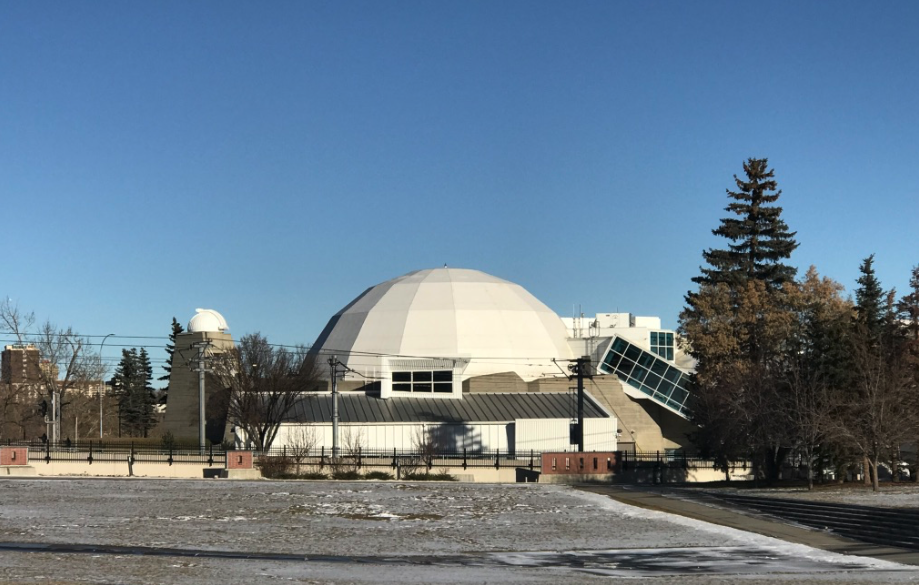
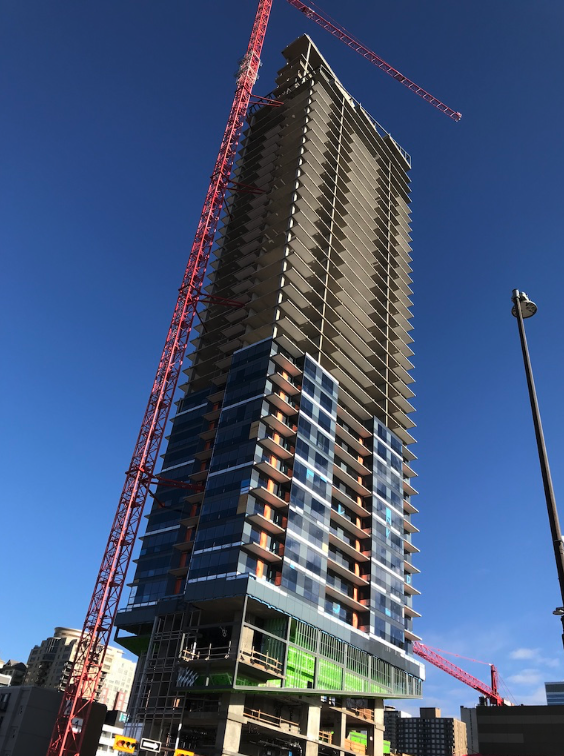
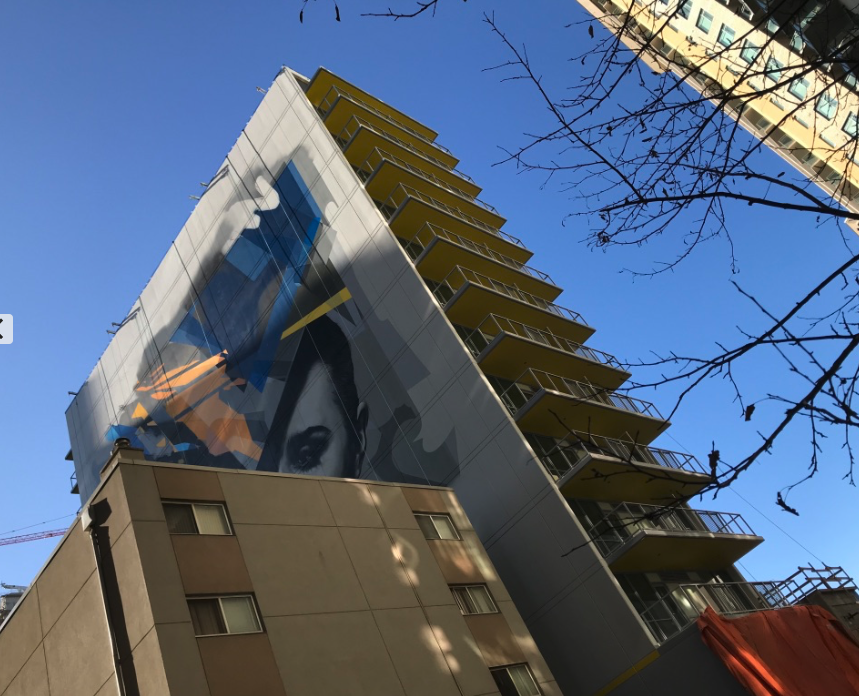
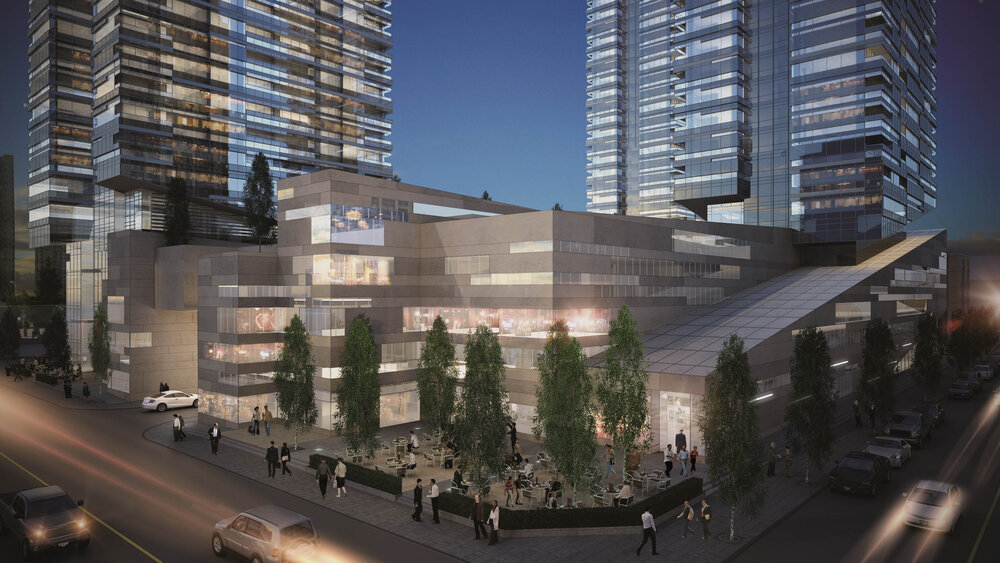
West Village Area Redevelopment Plan
In 2010, long before the Flames arena/stadium proposal, city council approved an ambitious plan to redevelop West Village.
It has much in common with East Village’s master plan, with its focus on creating robust public spaces, a pleasant pedestrian experience, connections to neighbouring communities (Sunalta, Downtown West and West Hillhurst) and a river walk .
Like East Village, it is divided into precincts - Gateway (east) Promenade (centre) and Pumphouse (west) - each with its own unique character.
The Plan envisions:
A 16th Street Boulevard from the Sunalta LRT station to the Bow River as a pedestrian mall and shopping street
A “Grand Staircase” linking the elevated Sunalta LRT station to the 16th Street Boulevard over 9th Avenue SW
A riverfront promenade that will function much like Riverwalk in East Village
A residential district next to Pumphouse Theatre Park
A roundabout at 14th Street and Bow Trail, surrounded by high-rise towers
Westbound Bow Trail will continue to be the main artery out of the downtown core, however it will be tree-lined, with wide sidewalks and curbside parking in off-peak times on one side
A pedestrian bridge over the Bow River at 19th Street SW, connecting West Village to West Hillhurst
Jessica Karpat was a planner with the city from 2005 to 2011, when the ARP was being developed. She says, “Unfortunately, the ARP is already 10 years old and will likely never be used as originally conceived. It will need significant amendments, prior to any development as market conditions will be vastly different, mobility and land use has and will evolve beyond the existing concept, and new infrastructure investments made in the area has cemented the need to reconsider the development opportunities in West Village as a whole.”
Conceptual drawing of West Village River Promenade from West Village ARP.
Do we really need West Village redevelopment?
Currently, Calgary has several new urban villages, all at various stages of development, and several inner city communities undergoing revitalization.
There is only so much demand for new urban living over the next 20 years. The addition of another major master-planned community would no doubt cannibalize development in other parts of the city.
Current revitalization of established communities:
Beltline
Bridges
Inglewood
Kensington
Marda Loop
Mission
Current new master-planned urban communities:
East Village
Rivers District
Currie
University District
University City/Brentwood LRT Station
Greenwich Trinity Hills
West District
East Village won’t be fully built out until 2027 and the Rivers District, aka Victoria and Stampede Park, won’t be finished until probably the late 2030s. The others won’t be finished until the late 2020s to mid 2030s, depending on how Calgary adapts to the economic realities of the 21st century.
Diagram from West Village ARP illustrating height and density of development.
East Village neglected for 40 years
It should be remembered that East Village lay fallow for about 40 years before it was finally redeveloped.
The 1964 Downtown Plan called for the redevelopment of the downtown’s eastside, including Churchill Park, the name for East Village at the time. However, it wasn’t until the early ‘70s that three affordable housing projects for seniors were built in East Village – Kings Tower, Murdoch Manor and the Golden Age Club.
Then there was nothing for another 20 years until two homeless shelters were added to East Village -- the Drop In Centre (the largest homeless shelter in North America) and the Salvation Army’s Centre of Hope for homeless men.
In the late ‘90s ambitious plans were developed to revitalize East Village as part of Calgary’s Expo 2005 bid. When that bid failed, Mayor Al Duerr and Councillor Bev Longstaff championed a controversial private sector plan to redevelop East Village with high-rise residential development. When they both retired in 2001, the plan was dropped.
With the demise of the private sector plan, new mayor Dave Bronconnier and Councillor Druh Farrell championed a new vision for East Village. They worked with city administration to develop ideas and plans for several years, and then, in 2007, worked with their council colleagues and the province to establish one of Canada’s first Community Revitalization Levies (a planning tool that allows municipalities to borrow against future property tax revenues to help pay for infrastructure to spur new development in a specific area) and an arm’s length entity, the Calgary Municipal Land Corporation (CMLC), to develop East Village.
The East Village Master Plan was approved in 2009 after significant community consultation. Luckily, 2009 was a time of economic prosperity and optimism for Calgary, and a renaissance in urban living across North America.
Yes, it took 40-plus years until the stars aligned for East Village redevelopment.
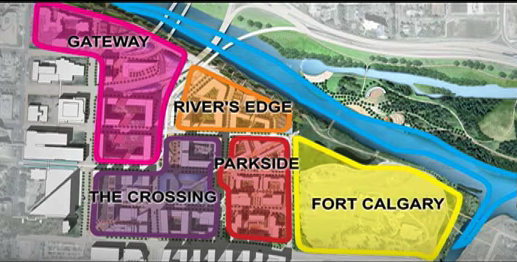

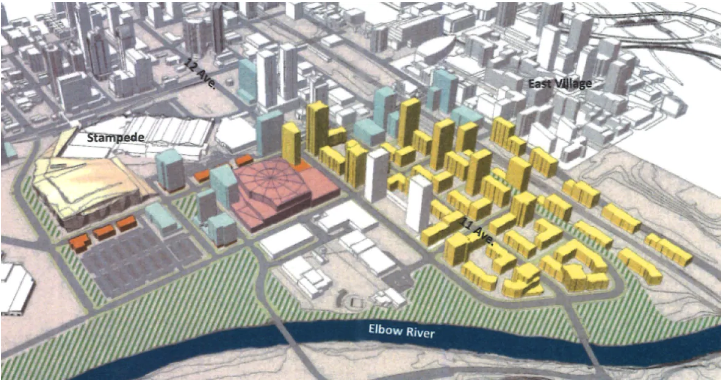
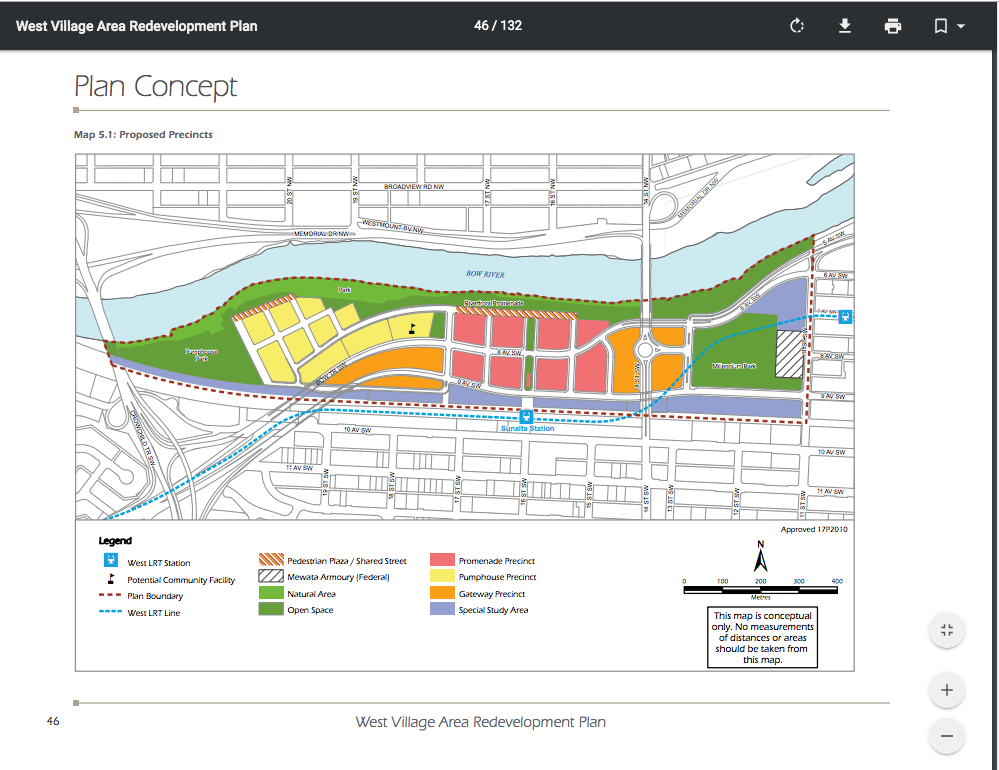
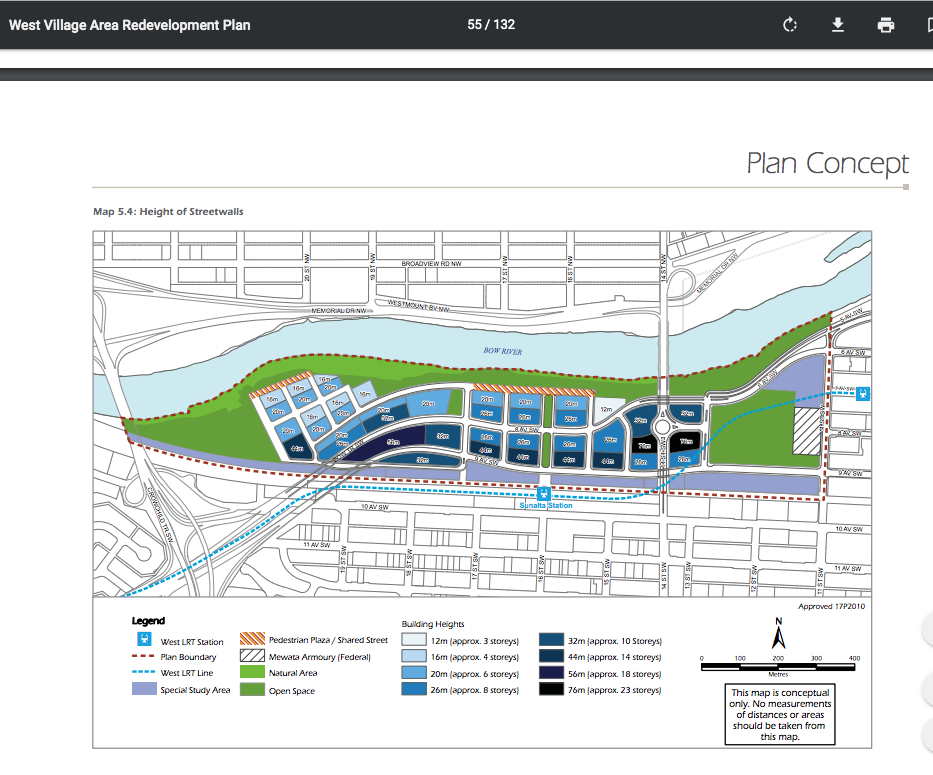
LAST WORD
I reached out to Chris Ollenberger of QuantumPlace Developments, the founding president and CEO of the CMLC and an instrumental player in the development and approval of the East Village master plan, to get his thoughts on West Village redevelopment.
“I think many people forget how long it took for the right pieces to fall into place to enable East Village redevelopment, “ said Ollenberger in an email.
“Yes, West Village has many of the same elements as East Village - City owns the majority of the land, it has the critical land mass necessary for a Community Revitalization Levy if needed and its river edge location is attractive. However, I don’t think there is the political or fiscal will to create another CRL given the current economic climate, nor to address the creosote contamination and the current heavy use of Bow Trail for vehicle movement. East Village didn’t have these constraints, which must be resolved before West Village redevelopment can happen.”
Ollenberger added, “Some people may lament West Village isn’t being as actively pursued as the Rivers District, but I think that is smart for our city. We need to let East Village and East Victoria Park play out. West Village will be there when we need it, and we will need it someday. But not today.”
Note: An edited version of this blog was published by CBC Calgary as part of its The Road Ahead online feature on Saturday January 18, 2020. . Link: Calgary West Village Future.
If you like this blog, you will like these links:
Do we really need to develop West Village?






